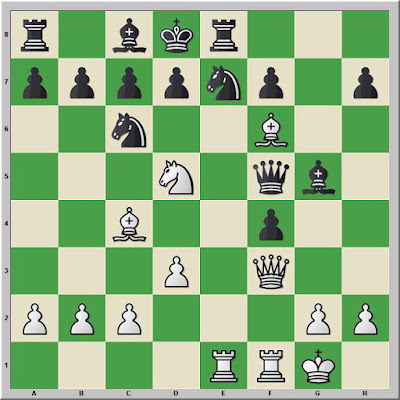I spent several hours Sunday morning going through Chigorin -- Davidov, St. Petersburg 1874. Chigorin played a Muzio Gambit, quickly brought all of his pieces to bear in the attack, and succeeded in checkmating his opponent's king. Davidov's queen's rook was a spectator. Despite White's knight sacrifice, he always had a material advantage in the battle.
Chigorin,Mikhail -- Davidov,Mikhail [C37]
St Petersburg, 1874
1.e4 e5 2.f4 exf4 3.Nf3 g5
How many White moves are playable here? Is one better than the others? 4.Bc4 Seems sensible as it directly attacks f7. It usually leads to the Muzio Gambit with a knight sacrifice, however.
4.h4 has lots of theory.
4.Nc3 is recommended by John Shaw for players seeking a line with less theory.
4.d4 seems playable.
4...g4
4...Nc6 is recommended by John Shaw, The King's Gambit (2013). He thinks that White should not play 4.Bc4, and that Black should not reply 4...g4.
5.0–0
White gives up a knight for rapid development.
5.Ne5 Qh4+ (5...d5) 6.Kf1 saves the piece. (6.g3 fxg3) 6...Nh6.
5...gxf3 6.Qxf3 Qf6
6...Qe7
7.e5 Qxe5
White to move
8.d3
8.Bxf7+ is considered the principled move in the Muzio. However, the text is favored by 1/2 pawn by Stockfish 6, and more than 1/2 pawn by Komodo. 8...Kxf7 9.d4 Qf5 and Black is better, according to Shaw.
Shaw gives a reference game that I found in my database and also identified as of theoretical interest: 10.g4 Qg6 11.Nc3 Nf6 12.Bxf4 d6 13.Bg3 Kg7 14.Nd5 Nxd5 15.Qxd5 Nc6 16.Qc4 d5 17.Qxd5 Be6 18.Qb5 Be7 19.Qxb7 Qe4 20.Rae1 Qxd4+ 21.Rf2 Bd7 22.Qxc7 Bc5 23.Kg2 Qd5+ 24.Rf3 Rhf8 25.Bf4 Rac8 26.c4 Qxf3+ 0–1 Showalter,J--Taubenhaus,J, New York 1889.
8...Bh6 9.Nc3
9.Bd2 was also popular in the nineteenth century.
9...Ne7 10.Bd2 Nbc6 11.Rae1 Qf5
All of White's pieces are mobilized.
White to move
12.Nd5
In my database is a reference game that led to a long struggle and eventually a victory for Black. 12.g4 Rg8 13.h3 Nd4 14.Qf2 Ne6 15.d4 c6 16.Bd3 Qf6 and Black won in 81 moves, Anderssen,A--Neumann,G, Berlin 1866.
12...Kd8
Forced.
13.Bc3 Re8
13...Rg8 was played in two earlier games, and it would not be unreasonable to suppose that Chigorin knew these games. Davidov, too, probably had studied them. 14.Bf6 Bg5
(14...Bf8 led to catastrophe 15.Qe2 Qe6 16.Nxe7 Qxe2 17.Nxc6+ Ke8 18.Rxe2+ 1–0 Cochrane,J--Mahescandra, Kolkata 1854)
15.Rxe7 Bxf6 16.Re4 Bg5 17.g4 Qg6 18.h4 Bxh4 19.Qxf4 d6 20.Qxf7 Qxf7 21.Rxf7 Ne5 22.Rxh7 Nxc4 23.Rxc4 c6 24.Nc7 Rb8 25.Rf4 Be7 26.Rff7 Kxc7 27.Rxe7+ Kb6 28.Rhg7 Rxg7 29.Rxg7 Be6 30.Rg6 Bxa2 31.Rxd6 Rg8 32.Kf2 Rxg4 33.Ke2 Rg2+ 34.Kd1 Bb1 35.c3 Rxb2 0–1 Kolisch,I--Paulsen,L, London 1861.
14.Bf6 Bg5
Perhaps Davidov was remembering the Paulsen win above, but the position is different. Paulsen played 14...d6 is this position. That game went on 15.Bb5 Be6 16.Bxc6 bxc6 17.Bxe7+ Rxe7 18.Nxe7 Qc5+ 19.d4 Qxd4+ 20.Kh1 Kxe7 21.Qxc6 Rc8 22.c3 Qb6 23.Qe4 Rg8 24.Qxh7 Rg6 25.Re2 Qc5 26.Qh8 Kd7 27.Qa8 Qc6 28.Qxc6+ Kxc6 29.b3 Kd7 30.c4 Bf5 31.Rfe1 Re6 32.Kg1 Bg4 33.Re4 Bf5 34.R4e2 Bd3 35.Rxe6 fxe6 36.Kf2 e5 37.g3 fxg3+ 38.hxg3 e4 39.Rh1 Bd2 0–1 Schallopp,E--Paulsen,L, Berlin 1864.
White to move
The game has reached one of the middlegame positions in Ziyatdinov's text.
15.g4 Qg6 16.Bxg5 Qxg5 17.h4 Qxh4 18.Qxf4 d6 19.Nf6
Black to move
Ne5?
19...Rf8 defends against White's short-term threats.
20.Rxe5
With the exchange sacrifice, White falls further behind in the material on the board. However, he maintains an edge with the material in the battle balanced and Black's pieces tied down. Despite the absence of a pawn shield for the White monarch, Black's king is the one under pressure.
One of my students was able to find 20.Rxe5 rather quickly, although he credited the understanding that came from my suggestion that Black should have played 19...Rf8. In training, we often know that a decisive position has been reached in the game we are examining. While playing, these moments are less clear.
20...dxe5 21.Qxe5 Bxg4
21...Bd7 may hold.
22.Qd4+ Kc8
White to move
This position also appears in GM-RAM.
23.Be6+ Kb8
23...Bxe6 24.Qxh4.
23...fxe6 24.Qd7+ Kb8 25.Qxe8+ Nc8 26.Nd7#.
24.Nd7+ Kc8 25.Nc5+ Kb8
25...Bxe6 26.Qxh4.
26.Na6+ bxa6 27.Qb4# 1–0
I found some tactical positions in this game that I was able to use with my students, advancing their knowledge as well as my own. Cochran's miniature and Paulsen's two games offer additional study material and training positions.
The next in the series is Steinitz -- Blackburne, London 1876, first match game.


















No comments:
Post a Comment